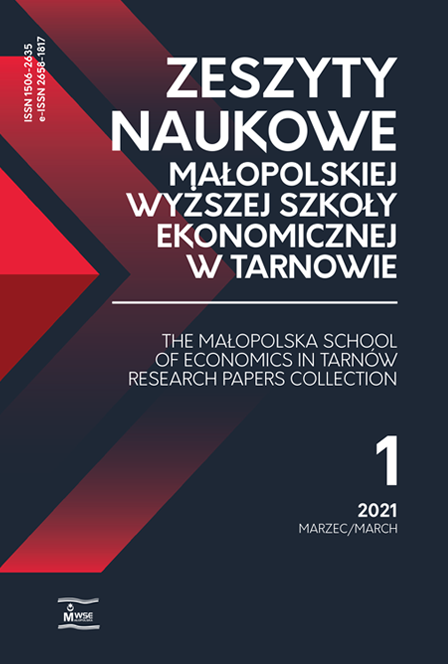Abstract
Dynamic changes that are taking place in contemporary companies and their environment, development of information and communications technologies (ICT) create new human expectations and needs. Due to the global ageing of societies, increasingly more companies are treating the elderly as a key factor of their success, looking at innovation from the perspective of customer value and improvement of internal processes. The purpose of the article is to formulate the challenges faced by companies in the context of older people, and an attempt to define the attitudes of seniors towards innovation in the area of mobile technologies. The study is cross-sectional and can be used to create marketing strategies for managers of innovative.
companies operating on the silver consumer market.
References
American Academy of Neurology. (2012). Geriatric Neurology Fellowship Core Curriculum [online, accessed: 2020-05-14]. Retrieved from: https://www.aan.com/uploadedFiles/Website_Library_Assets/Documents/8Membership/3People/.
View in Google Scholar
Badowska, S., Rogala, A. (2015). Przełamanie stereotypizacji konsumentów-seniorów a implikacje dla marketingu. Zeszyty Naukowe Uniwersytetu Szczecińskiego. Problemy zarządzania, finansów i marketingu, 41(1), 11–23. DOI: 10.18276/pzfm.2015.41/1-01.
View in Google Scholar
Barska, A., Śnihur, J. (2017). Senior as a challenge for innovative enterprises. Procedia Engineering, 182, 58–65. DOI: 10.1016/j.proeng.2017.03.115.
View in Google Scholar
Bondos, I. (2013). Dlaczego seniorzy stanowią wyzwanie dla marketingu? Marketing i Rynek, 3, 31–36.
View in Google Scholar
Cesta, A., Cortellessa, G., Giuliani, M. V., Pecora, F., Scopelliti, M., Tiberio, L. (2007). Psychological implications of domestic assistive technology for the elderly. PsychNology Journal, 5(3), 229–252.
View in Google Scholar
Drucker, P. F. (1992). Innowacja i przedsiębiorczość. Warszawa: Polskie Wydawnictwo Ekonomiczne. ISBN 8320808707.
View in Google Scholar
Frąckiewicz, E. (2019). Nowe technologie na rynku srebrnych konsumentów. Stan, uwarunkowania, perspektywy. Warszawa: CeDeWu. ISBN 9788381022712.
View in Google Scholar
Gamberini, L., Raya, M. A., Barresi, G., Fabregat, M., Ibanez, F., Prontu., L. (2006). Cognition, technology and games for the elderly: An introduction to ELDERGAMES Project. PsychNology Journal, 4, 285–308.
View in Google Scholar
Golińska-Pieszyńska, M. (2011). Polskie praktyki innowacyjne. Aspekty teoretyczne i badania empiryczne. Warszawa: Oficyna Wydawnicza SGH. ISBN 9788373785915.
View in Google Scholar
Hinton, P., Brownalo, C., McMurvay, I., Cozeb, B. (2004). SPSS explained. London: Routledge. E-book. ISBN 9780203642597.
View in Google Scholar
Janasz, K., Wiśniewska, J. (2014). Strategie innowacyjne organizacji. In: A. Kaleta, K. Moszkowicz, L. Sołoducho-Pelc (eds.). Zarządzanie strategiczne w teorii i praktyce, 366 (pp. 184–194). Wrocław: Wydawnictwo Uniwersytetu Ekonomicznego we Wrocławiu. ISBN 9788376954035.
View in Google Scholar
Jelonek, D. (2014). Ocena internetowych kanałów komunikacji z klientem w procesie współtworzenia innowacji. Informatyka Ekonomiczna, 31, 318–329.
View in Google Scholar
Kall, J. (2015). Branding na smartfonie. Komunikacja mobilna marki. Warszawa: Oficyna a Wolters Kluwer Business. ISBN 9788326414794.
View in Google Scholar
Kinnealey, M., Oliver, B., Wilbarger, P. (1995). A phenomenological study of sensory defensiveness in adults. The American Journal of Occupational Therapy, 49, 444–451. DOI: 10.5014 / ajot.49.5.444.
View in Google Scholar
Lewis, D. (2012–2013). Older by age, younger by mindset: The attitudes and behaviours of the over 50s and how to communicate with and market to this group. Journal of Brand Strategy, 1(4).
View in Google Scholar
Łysik, Ł., Kutera, R. (2013). Technologie mobilne jako determinanta rozwoju innowacyjnego społeczeństwa informacyjnego. Zeszyty Naukowe Uniwersytetu Szczecińskiego. Europejska przestrzeń komunikacji elektronicznej, 105(2), 32–44.
View in Google Scholar
Niedzielski, P., Rychlik, K. (2006). Innowacje i kreatywność. Szczecin: Wydawnictwo Naukowe Uniwersytetu Szczecińskiego. ISBN 8372415730.
View in Google Scholar
Parasuraman, A. (2000). Technology readiness index (TRI): A multiple-item scale to measure readiness to embrace new technologies. Journal of Service Research, 2. DOI: 10.1177/109467050024001.
View in Google Scholar
Renaud, K., van Biljon, J. (2008). Predicting technology acceptance and adoption by the elderly: A qualitative study. SAICSIT ‘08: Proceedings of the 2008 annual research conference of the South African Institute of Computer Scientists and Information Technologists on IT research in developing countries: riding the wave of technology, Wilderness, South Africa, 6–8 October 2008, 210–219. DOI: 10.1145/1456659.1456684.
View in Google Scholar
Schumpeter, J. A. (1960). Teoria rozwoju ekonomicznego, Warszawa: Państwowe Wydawnictwo Naukowe.
View in Google Scholar
Sony-Aibo ERS-7. (2018). [online, accessed: 2020-05-10]. Retrieved from: http://www.sony-aibo.com/aibo-models/sony-aibo-ers-7/.
View in Google Scholar
Szmigin, I., Carrigan, M. (2000). The older consumer as innovator: Does cognitive age hold the key? Journal of Marketing Management, 16(5). DOI: 10.1362/ 026725700785046038.
View in Google Scholar
Sznajder, A. (2014). Technologie mobilne w marketingu. Warszawa: Oficyna a Wolters Kluwer business. ISBN 9788326432125.
View in Google Scholar
Szukalski, P. (2012). Trzy kolory: srebrny. Co to takiego silver economy? Polityka Społeczna, 39(5–6[458–459]), 6-11.
View in Google Scholar
Trafiałek, E. (2006). Starzenie się i starość. Wybór tekstów z gerontologii społecznej, Kielce: Wydawnictwo Uczelniane Wszechnica Świętokrzyska, 267–275. ISBN 838827418X.
View in Google Scholar
Wakefield, J. (2015). The generation that tech forgot [online, accessed: 2020-06-06]. Retrieved from: http://www.bbc.com/news/technology-32511489.
View in Google Scholar
WHO. (2020). [online, accessed: 2020-05-10]. Retrieved from: https://www.who.int/ageing/projects/age_friendly_cities_network/en/.
View in Google Scholar
Wiśniewska, S. (2013). Skuteczność niekomercyjnych instytucji otoczenia biznesu we wspieraniu innowacji marketingowych małych i średnich przedsiębiorstw. Kraków: Wydawnictwo Uniwersytetu Ekonomicznego w Krakowie. ISBN 13: 9788372526977.
View in Google Scholar
World Population Ageing. 2019. [online, accessed: 2020-05-10]. Retrieved from: https://www.un.org/en/development/ desa/population/theme/ageing/index.asp.
View in Google Scholar
Żurawski, T. (2015). Jak mówić – bo warto! – do 50+. Marketing w Praktyce, 2.
View in Google Scholar

This work is licensed under a Creative Commons Attribution-NonCommercial-NoDerivatives 4.0 International License.

